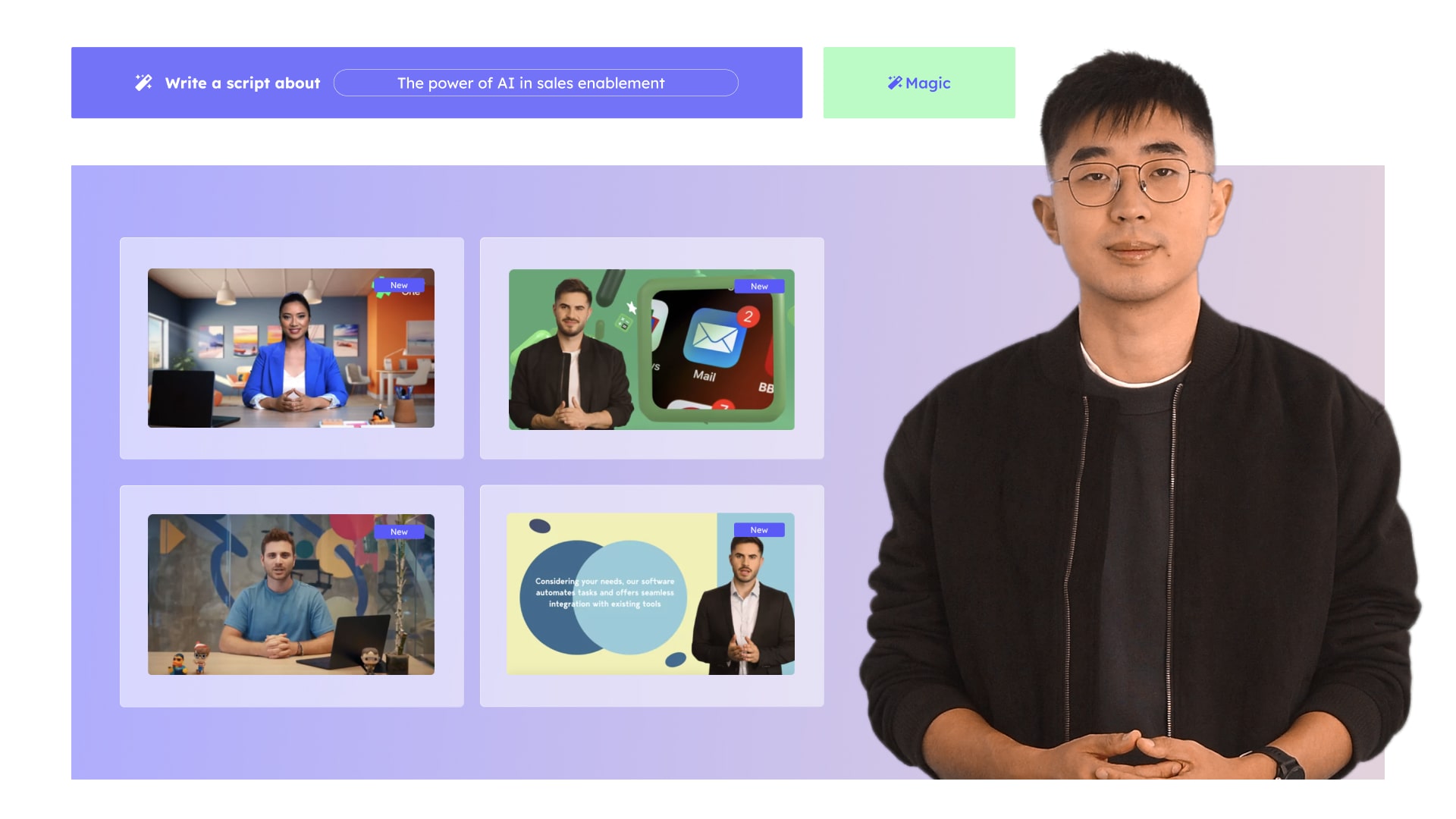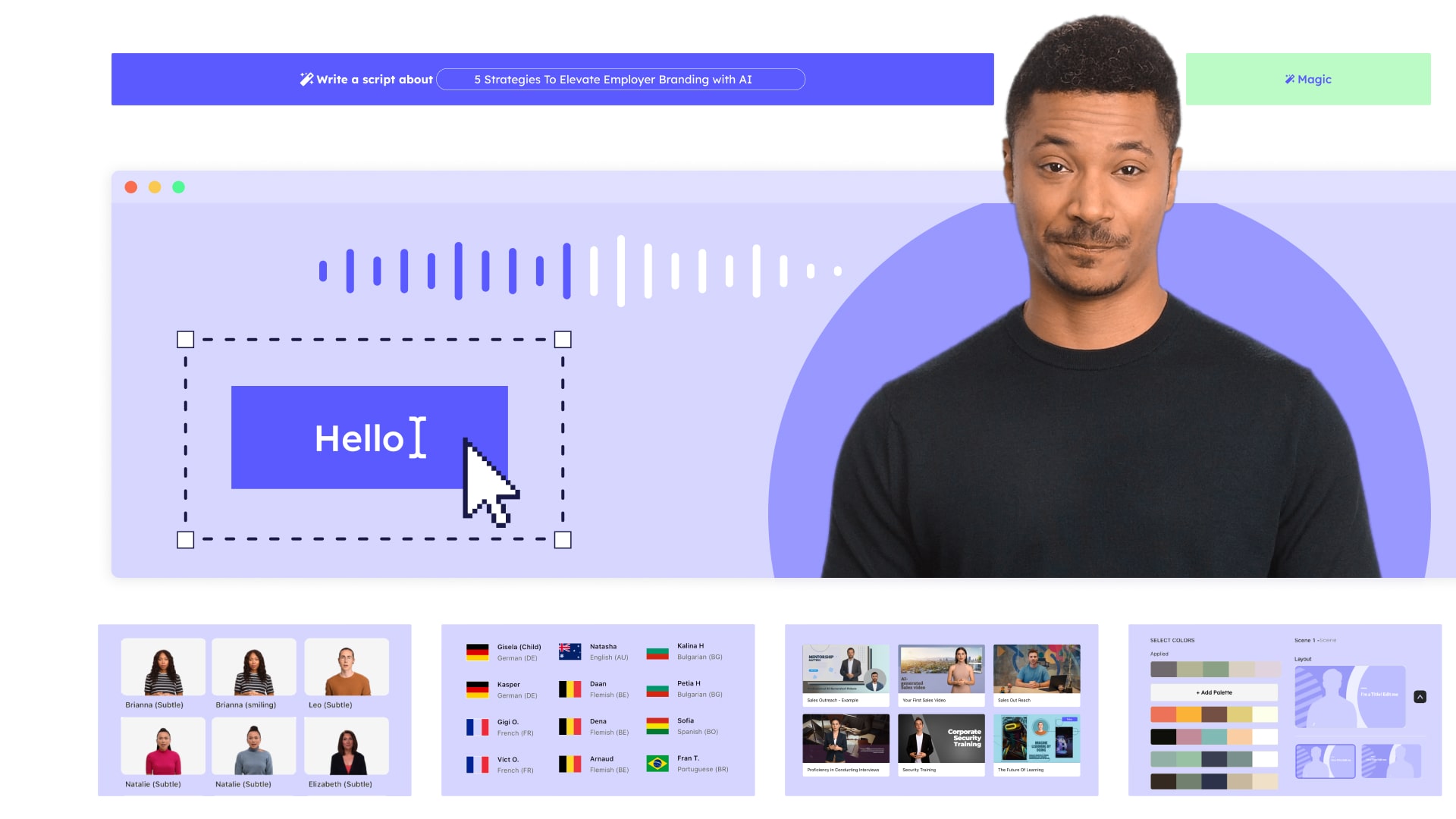Video learning has transitioned from being an innovative concept to a widely accepted norm in corporate learning and development (L&D). The use of video for content delivery has seen a significant surge in recent times, and this growth is well-justified. Video has established itself as an efficient, cost-effective, and adaptable method for training, offering numerous advantages.
However, creating impactful video content isn’t without its challenges. Traditional video production methods can be resource-intensive and time-consuming, posing significant hurdles for L&D professionals. This is where the transformative power of AI comes into play.
As we navigate through 2024, it’s vital to understand the current video trends and statistics shaping the role of video in L&D. This article delves into the latest insights, highlighting the significance of video in enhancing learning experiences. We will compare traditional video production techniques with innovative AI-driven approaches, showcasing how AI is not only streamlining the process but also delivering significant savings in time and resources. With AI, L&D videos enable a future where learning is more dynamic, personalized, and accessible than ever before.
Current Video Trends in L&D
According to statistics from the SAVO group, it’s striking that an average employee forgets 65% of the material covered within just a week of training completion, increasing to 90% over six months. This data underscores the critical need for engaging and memorable training methods. Reflecting this necessity, video in L&D is witnessing substantial growth and notable trends. Key video statistics that highlight this evolution include:
-
- The global e-learning market is expected to be worth $325 billion by 2025, with eLearning contributing to a 42% increase in income for US organizations.
-
- Companies with comprehensive training programs using L&D videos have seen an impressive 218% higher revenue per employee
-
- eLearning can reduce learning time by 40-60% compared to traditional classrooms
-
- Two in five Fortune 500 companies use eLearning tools.
In 2023, the use of video in L&D is particularly crucial for larger organizations grappling with disjointed practices and thinking due to their large structures. With multiple locations and hundreds or even thousands of employees, these organizations often struggle with effective communication across different departments. With video, L&D teams can produce content seamlessly, fostering a unified understanding of specific topics.
L&D video content is dominated by three primary delivery formats: training videos, slide presentations, and eLearning modules. These formats cater to a variety of learning styles and preferences, providing both visual and auditory engagement. The top training video topics are technical training, employee development, and employee onboarding, addressing key areas of organizational growth and skill enhancement.
The usage of video in L&D is primarily driven by three reasons: to support a microlearning strategy by offering a deep and detailed explanation of a product or service, to provide more on-demand learning content for self-directed learning, and to deliver content in multiple languages, thereby catering to a diverse and global workforce. This video trend reflects a growing emphasis on flexible, accessible, and inclusive learning solutions.
The ability to craft key messages in an engaging, easily distributable format, accessible worldwide at a low cost, is invaluable. It significantly reduces information overload and ensures consistency in core company messages, addressing the challenges of fragmented communication in large-scale enterprises.
Challenges in Traditional L&D Video Creation
Creating traditional video productions for businesses comes with its share of challenges. One key issue is the need for specialized skills in video production, including shooting and editing, which might necessitate training existing employees or outsourcing. Budget constraints are another significant hurdle, with the costs of equipment and production often being substantial. A notable 16% of respondents have refrained from producing videos due to the time-intensive nature of the process, lack of specialized skills, and high costs involved. The most time-consuming aspects of traditional video production are editing, filming or creation, and scriptwriting, which can significantly slow down the process.
Additionally, ensuring that the created video content reaches the intended audience effectively requires a well-thought-out promotional strategy that integrates various distribution channels. Another crucial consideration is making videos accessible to all audience members, including those with hearing impairments or global audiences, which demands additional steps like captioning and translation.
These obstacles highlight the need for careful planning, resource allocation, and skill development to leverage videos effectively. Such challenges underscore the necessity for more efficient approaches, such as AI tools, which offer benefits like reduced production time and costs, ease of updating content, and simplified localization.
AI in L&D Video Production
When approaching the task of creating a training or education video, understanding the differences between traditional methods and AI-enhanced techniques is crucial. Reflecting on factors such as efficiency, cost, and capabilities of both approaches will help businesses choose the most suitable method for their needs.
| Aspect | Traditional Video Production | AI-Enhanced Video Production |
| Skill Requirement | Requires substantial human skill in scripting, shooting, editing | Easy to use, even for those with no prior experience |
| Process | Resource-intensive, involving manual tasks at various stages | Automates tasks like subtitle creation, script formulation |
| Creative Flexibility | Offers creative freedom but is limited by demands of technical skills and resources | Enhances creativity with features like lifelike virtual presenters |
| Adaptability | Limited flexibility in updating content | Allows for quick edits and updates in response to changes without reshooting |
| Accessibility | Limited in scope, often restricted to a single language | Facilitates multi-language production, reaching a diverse audience |
| Cost and Time Efficiency | Time-consuming and often costly due to manual efforts | Time-saving and cost-effective, reducing the need for professional editing |
| Training Consistency | Potential for variance in training delivery | Ensures uniform training and knowledge dissemination across the organization |
Integrating AI in employee training is reaping significant time and resource savings. Modern AI tools have slashed the average training video production time by 62%, reducing it by 8 days. Based on a survey completed by Academy Ocean, companies using AI for training are seeing notable benefits, presenting the following video statistics: a 20.41% time saving, an 18.87% boost in efficiency and cost-effectiveness, and a 15.30% improvement in personalized learning experiences. Significantly, 19.85% of respondents highlighted AI’s capacity for delivering personalized learning paths, underscoring its ability to meet individual learning needs and preferences.
The Future of AI in L&D Videos
The growing capabilities of AI is reshaping the future of video production in L&D. AI is set to revolutionize the L&D industry, offering personalized and on-demand learning experiences. Expected to reshape the way we learn, train, and develop skills, the following are five key ways that AI will impact L&D:
-
- Advanced Personalization: The future AI in L&D videos will likely use deeper learning analytics to create hyper-personalized video content that adapts to the learner’s progress, preferences, and performance.
-
- Immersive Learning Environments: With the integration of AI, virtual, and augmented reality in videos, learners will experience more immersive and interactive learning environments, simulating real-world scenarios for practical learning and skill application.
-
- Predictive Learning Pathways: AI could predict individual learning needs and career paths, recommending specific video content that aligns with future skills requirements and personal career aspirations.
-
- Automated Content Creation: It is expected that AI will advance to autonomously generate and update video content based on emerging trends and organizational needs, ensuring continuous relevance and timeliness of learning materials.
-
- Enhanced Engagement Analysis: Future AI tools could provide more valuable insights into learner engagement and comprehension through videos, using advanced metrics to improve content effectiveness and instructional design.
AI aims complement human trainers, not replace them. As smart as AI is, it still lacks unique qualities like emotional intelligence in the learning experience. The synergy between AI and human trainers promises a comprehensive learning environment catering to diverse needs, with significant benefits for both employees and employers.
L&D Videos with Hour One
AI video learning, an increasingly pivotal element in L&D, has evolved from a popular video trend, to a norm in employee training. With platforms like Hour One, the integration of AI in video production has transformed employee training and oboarding, offering substantial time and resource savings with better performance results. AI video generation brings efficiency and personalization to L&D, ensuring content is accessible and engaging.
Featuring over 100 lifelike AI avatar presenters in various languages and accents, Hour One enhances engagement and knowledge retention while ensuring global accessibility for employees all over the world. As we move forward, AI training videos offer more dynamic and tailored learning experiences, enhancing both the learning journey and the overall educational impact.
Experience the future of L&D with a free trial of Hour One’s Text to Video AI Generator, and see how it seamlessly integrates into your LMS, transforming employee training into an engaging and personalized experience.








